Optimal Plants for Your Small Garden


Intro
The potential of a small garden is vast, provided the right plants are chosen. Each type of plant brings its own set of characteristics, preferences, and benefits. This guide will offer insights into the various categories such as herbs, vegetables, fruits, and ornamental plants. In doing so, we aim to empower visitors, turning small areas into beautiful and productive pockets of nature.
Feature Spotlight
Selecting the Right Plants
Cultivating a small garden offers the chance to curate a personal sanctuary. Choosing plants based on their growth habits and requirements ensures that the limited space is used effectively. A gardener should take into account sunlight exposure, potential growth size, and the arrangement of these plants.
- Herbs: Herbs are ideal for small gardens. They not only enrich the culinary experience but also add greenery. Varieties like basil, parsley, and cilantro grow well in pots or small patches.
- Vegetables: Opt for compact varieties of vegetables. Cherry tomatoes, radishes, and baby carrots fit well in confined spaces and provide high yields.
- Fruits: Smaller fruiting plants such as strawberries or compact dwarf varieties of apple trees can thrive. They bring both visual interest and the pleasure of harvest.
- Ornamental Species: Including plants like succulents or dwarf flowering varieties can enhance visual appeal, providing a balance between beauty and functionality.
"A well-planned garden can bring unexpected joy even in the smallest of spaces."
Practical Tips
When gardening with limited space, it becomes essential to utilize vertical gardening techniques, such as wall planters or hanging pots. This method not only saves ground space but also introduces unique design aspects to your garden. Consider the following tips:
- Maximize Vertical Space: Employ trellises for climbing plants.
- Group Plants by Light Needs: Grouping plants with similar sunlight requirements simplifies care routines.
- Rotate Crops Annually: This practice maintains soil health and reduces pests.
Adopting these methods can transform a small garden into a flourishing ecosystem, allowing a diverse range of plants to thrive together.
By selecting suitable plant species while employing practical gardening methods, any gardener can create a small haven filled with greenery. This guide aims to unlock the beauty and capacity held within constrained spaces, highlighting the fulfilling activity of gardening.
Understanding Small Gardens
Understanding small gardens is crucial for maximizing the potential of limited spaces. In urban settings and densely populated areas, where land is often scarce, small gardens serve as vital green spaces. They can transform a compact area into a productive and aesthetically pleasing environment. Additionally, small gardens offer an opportunity for individuals to engage in gardening, which benefits both mental health and physical well-being.
The experience of gardening can bring a sense of accomplishment and connection to nature. When gardeners can cultivate plants in constrained areas, they learn to focus on resource efficiency and aesthetics. They can create vibrant displays, growing herbs, vegetables, or ornamental plants. Moreover, understanding how to make the most out of a small garden can lead to increased yields from limited soil.
Defining a Small Garden
A small garden is typically characterized by its limited size, often measuring less than 100 square feet. However, the definition can vary depending on regional standards and individual circumstances. The essential point is that these gardens must be planned to optimize every inch for growth.
Key features of a small garden include:
- Plant selection: Choosing species that thrive in confined spaces.
- Efficiency: Using techniques that maximize yield, such as vertical gardening and companion planting.
- Accessibility: Ensuring that maintenance tasks remain manageable, even in tight quarters.
- Aesthetics: Creating an inviting atmosphere that enhances the living environment.
Herbs for Limited Areas
Growing herbs in small gardens not only maximizes space but also provides fresh flavors to meals. They are often compact plants that thrive in limited areas, making them perfect choices for novice and seasoned gardeners alike. Furthermore, herbs can be a solution to enhance the aesthetic appeal of a garden. Their variety in shapes, sizes, and colors can add depth to any small planting area.
Many herbs are low-maintenance and can be grown in containers, vertical gardens, or even along pathways, thus allowing gardeners to make the most of confined spaces. Using herbs in cooking or garnishing adds an elevated touch to dishes, bringing culinary experiences to a new level. Additionally, growing herbs reduces the need for store-bought options, promoting sustainability and self-sufficiency.
Basil: Versatile and Flavorful
Basil is a quintessential herb valued for both its culinary use and pleasant aroma. It is versatile, featuring in various cuisines, particularly Mediterranean and Asian. The plant has a bushy growth habit, making it suitable for small spaces. It can thrive in containers or as part of a companion planting scheme. This herb prefers warm temperatures and well-drained soil.
Basil can be harvested continuously without harming the plant, which encourages a longer growing season. Regular trimming promotes bushier growth, making it aesthetically pleasing as well. When deciding where to plant basil, consider its sunlight needs; it flourishes in full sun.
Mint: Robust with Ground Coverage
Mint is known for its refreshing flavor and vigorous growth. It can spread quickly, which makes it ideal for ground cover in small gardens. However, its invasiveness can be a concern, so planting in containers or confined areas ensures it will not take over. Mint prefers partial shade but can adapt to a variety of environmental conditions.
Beyond culinary uses, mint can also provide medicinal benefits. It is often used in teas and drinks, making it a practical addition to small gardens. The leaves can also provide a pleasant aroma, enhancing sensory experiences.
Chives: Ornamental and Edible
Chives are notable for their delicate flavor and attractive purple flowers. They are among the easiest herbs to grow, requiring minimal maintenance and care. Chives grow in clumps, taking up little space, which makes them well-suited for small gardens. They thrive in a sunny environment and require rich, well-drained soil.
Besides their culinary applications in salads and dishes, the blooms of chives can beautify a garden. The vibrant purple flowers attract pollinators such as bees, supporting local ecosystems. Chives can be harvested throughout the growing season, adding a fresh taste to meals.
In summary, incorporating herbs into limited gardening spaces not only optimizes your garden's potential but also enhances your culinary range and supports biodiversity. By selecting herbs like basil, mint, and chives, gardeners can create a productive and visually pleasing garden atmosphere.
Optimal Vegetables to Cultivate
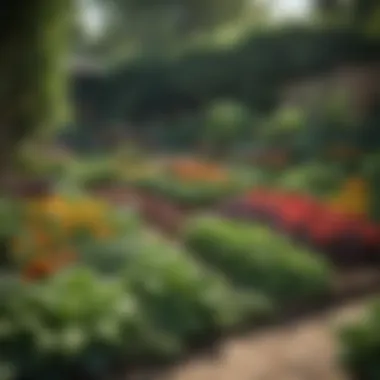
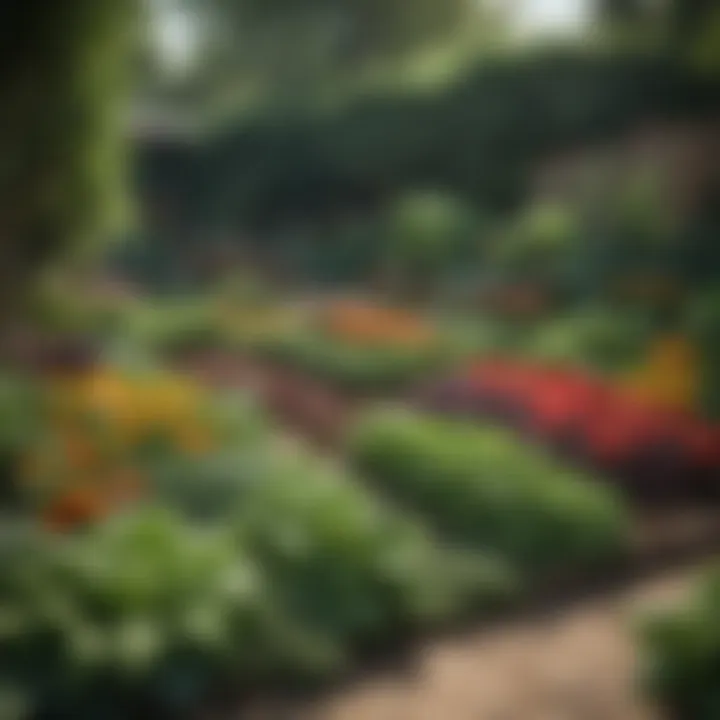
When considering the best plants for small gardens, vegetables play a critical role. They provide not only sustenance but also the satisfaction that comes from growing your own food. Selecting the right vegetables is essential for maximizing yield and ensuring healthy growth in limited space. A thoughtful approach can transform a small plot into a productive oasis.
Radishes: Quick and Easy Harvest
Radishes are an excellent choice for compact gardens. With a rapid growth cycle, they can be harvested in as little as three to four weeks. This fast turnaround provides immediate satisfaction and encourages continuous planting throughout the growing season. Radishes require minimal space, making them ideal for garden beds or container gardening.
Additionally, these root vegetables thrive in various soil conditions, though they prefer well-drained, loose soil.
Benefits of Growing Radishes:
- Rapid harvesting cycles enhance garden engagement.
- Compact size is perfect for limited areas.
- Versatile in culinary applications, adding crunch and flavor to many dishes.
Lettuce: Ideal for Small Spaces
Lettuce varieties, such as butterhead and leaf lettuce, are suited for space constraints. They can grow in small garden beds or containers, adapting well to limited environments. Lettuce is a cool-weather crop, thriving in mild temperatures. This makes it perfect for spring and autumn gardening in regions with temperate climates.
Lettuce also benefits from a practice called "cut and come again." This technique allows you to harvest leaves while leaving the plant intact, promoting continuous growth. Considerations for lettuce cultivation include proper spacing to avoid overcrowding and encouraging airflow.
Advantages of Growing Lettuce:
- Quick growth rate provides fresh greens fairly quickly.
- Can be re-harvested, enabling multiple cuttings from a single planting.
- Various flavors and textures can enhance meal variety.
Tomatoes: High Yield with Trellising
Tomatoes are often seen as staples in vegetable gardens, and for good reason. With proper care and support, such as stakes or trellises, tomatoes can flourish even in small spaces. The vertical growth of tomato plants maximizes the use of limited horizontal area, allowing you to grow a high yield of fruit without occupying too much ground.
Tomato varieties like 'Patio' and 'Tiny Tim' are specifically bred for container gardening and small spaces. These plants require ample sunlight, around six to eight hours daily. They also benefit from regular watering and sufficient nutrients, which can be monitored through proper fertilization.
Benefits of Growing Tomatoes:
- Climbing habits save space while increasing production.
- Variety of small and cherry types means options for diverse meals.
- Nutritional value is significant, offering vitamins and antioxidants.
By understanding the advantages and requirements of growing radishes, lettuce, and tomatoes, gardeners can create a productive and vibrant small garden. Each of these vegetables contributes its uniqueness while providing a rewarding gardening experience.
Fruits Suitable for Compact Gardens
Fruits play a critical role in small gardens. They add beauty, nutrition, and flavor to any small space. Growing fruits can also be rewarding, offering the chance to cultivate something unique right at home. Limited space need not deter the aspiring gardener. With careful selection, fruits can flourish in containers, vertical gardens, or small plots. Accessibility and maintenance are key considerations when choosing fruit plants for compact gardening.
Strawberries in Containers
Strawberries are an excellent choice for small gardens. They are versatile and can thrive in pots, hanging baskets, or even vertical setups. Container-grown strawberries often produce fruit more rapidly than those planted in the ground. The shallow root system allows for easy placement in various containers.
Maintaining strawberries is quite manageable. They require consistent watering and well-draining soil to prevent root rot. Choose varieties like 'Everbearing' or 'Alpine' that tend to produce strawberries throughout the growing season. Remember to clean them promptly after harvest to maintain plant health. The bright red fruits also serve as a decorative touch to any garden space.
"Containerized strawberries can enhance not only your meal but also your garden's aesthetics."
Dwarf Apple Trees: Space-saving Options
Dwarf apple trees are a notable option for compact gardens. These trees bear full-sized fruit but take up considerably less space. They usually grow between 5 to 8 feet tall, making them suitable for traditional gardens or patios. Choosing the right variety is essential. 'Honeycrisp' and 'Fuji' are popular for their taste and productivity.
These trees need adequate sunlight and space to spread their branches. Pruning will also help in maintaining a manageable size while encouraging better airflow. It's vital to plant them in well-drained soil, and ensure they receive enough water during dry periods. A dwarf apple tree not only provides fresh fruit but also serves as a lovely focal point in your garden.
Blueberries: Aesthetic and Edible
Blueberries offer a unique combination of ornamental appeal and edibility. They are bushy and can be grown in pots, making them ideal for small spaces. The bushes provide lovely foliage that changes with the seasons, alongside clusters of fruit. Varieties like 'Top Hat' and 'Jelly Bean' are specifically bred for compact growth.
These plants thrive in acidic and well-drained soil. Regular mulching can help maintain the right moisture level and protect roots. Additionally, blueberries are self-pollinating but planting multiple bushes can improve yield significantly. Besides their health benefits, the shrubs add visual interest to any space.
In summary, fruits suitable for compact gardens can transform a small area into a functional and beautiful space. With strawberries, dwarf apple trees, and blueberries, gardeners can enjoy homegrown produce without sacrificing aesthetics.
Ornamental Plants to Enhance Aesthetics
Incorporating ornamental plants into a small garden has significant importance. They not only beautify the space but also serve as an expression of personal style. The right selection of ornamental plants adds color and texture, creating visual interest and ambiance. These plants play a role in attracting pollinators, which can be beneficial for other plants in the garden. Furthermore, they can create a sense of privacy and confinement, thus enhancing the overall experience of a small garden.
Selecting ornamental plants requires considering their growth habits, care needs, and how they fit within the existing design. Also, it is important to think about seasonal appeal and resilience, especially in varying climates. By choosing the right ornamental plants, gardeners can create a vibrant, inviting space even in limited areas.
Succulents: Low Maintenance and Diverse
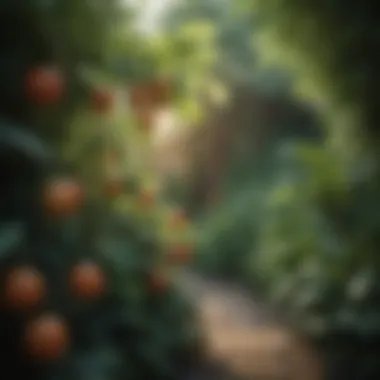
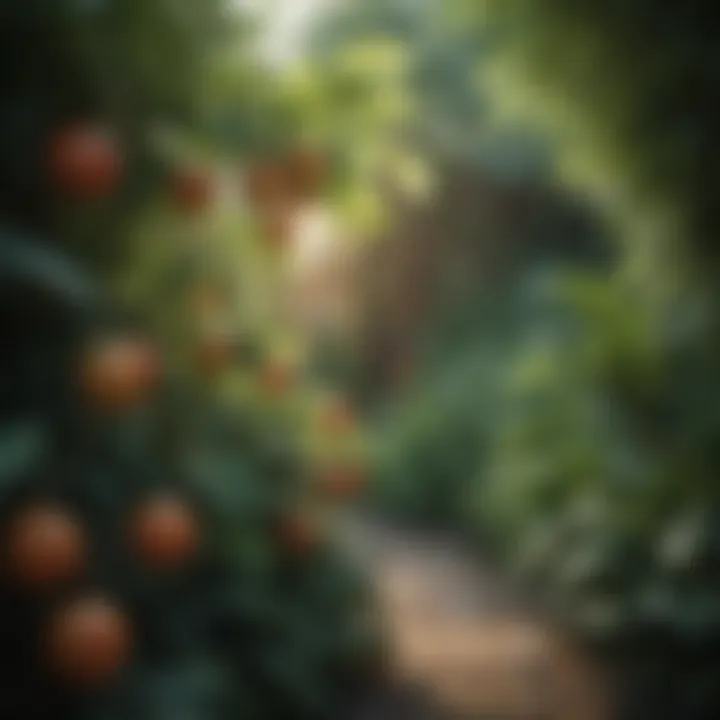
Succulents have become popular for small gardens due to their unique shapes and minimal care requirements. They come in a variety of textures and colors, which allows for creative combinations. These plants thrive in well-drained soil and require infrequent watering, making them ideal for those with busy schedules.
Some common types of succulents include:
- Echeveria: Offers rosette shapes and comes in various shades.
- Sedum: Hardy and ground-covering, often blooms with lovely flowers.
- Aloe Vera: Not only decorative but has medicinal properties.
Because of their adaptability, succulents can be used in containers or in the ground, making them suitable for varying gardening styles and spaces.
Pansies: Colorful Seasonal Flowers
Pansies are an excellent choice for adding color to small gardens, particularly in cooler months. Their vibrant blooms come in an array of hues, from deep purples to bright yellows. They are hardy and can thrive in various soil types, making them easy to care for. Pansies typically bloom in spring and fall, bringing seasonal charm to the garden.
These flowers need
- Full sun to partial shade.
- Regular watering to keep the soil moist.
- Deadheading to encourage new blooms.
Pansies create cheerful garden spaces and can be utilized in borders or container arrangements, enhancing aesthetics and inviting warmth and friendliness to any small garden.
Ferns: Lush Foliage for Shade
Ferns can bring lush greenery to shaded areas of a small garden, creating a calming environment. Their feathery leaves add texture and depth, complementing flowering plants beautifully. Different types of ferns vary in size and shape, which can offer diverse visual experiences in garden design.
Some popular varieties include:
- Boston Fern: Known for its cascading fronds, ideal for hanging baskets.
- Japanese Painted Fern: Features striking silver and purple foliage.
- Maidenhair Fern: Delicate and elegant, perfect for shady spots.
Ferns prefer moist, well-draining soil and indirect light, making them suitable for various garden conditions. They provide an appealing contrast to other plants, enhancing the overall aesthetic while requiring relatively little maintenance.
Strategies for Maximizing Space
Maximizing space in a small garden is essential for any enthusiast looking to create a diverse and productive green area. Small gardens often present unique challenges, including limited room for plant growth and the need for effective organization. Implementing thoughtful strategies can enhance both functionality and aesthetics of these spaces. Here, we explore specific elements that are vital for maximizing space and the benefits they provide.
Vertical Gardening Techniques
Vertical gardening is a powerful method that allows gardeners to utilize vertical surfaces to grow plants. This approach can significantly increase the amount of greenery without requiring additional ground space. Walls, trellises, and fences can be transformed into lush plant displays. Plants such as peas, cucumbers, and climbing beans thrive in vertical setups, making them ideal for small gardens.
Key benefits of vertical gardening include:
- Maximized Space: Vertical gardens use less horizontal area, making the most of limited space.
- Improved Air Circulation: Plants receive better airflow, reducing the risk of pests and diseases.
- Aesthetic Appeal: Vertical gardens create visually striking displays that can enhance a garden’s beauty.
Container Gardening Essentials
Container gardening is another effective strategy that helps optimize the use of small spaces. By choosing the right pots and containers, gardeners can grow a variety of plants, including herbs, vegetables, and flowers. The flexibility of placing containers allows easy rearrangement to maximize sunlight exposure and aesthetic arrangement.
To get started with container gardening, consider these essentials:
- Container Size: Ensure that pots are adequately sized for the plants you choose. Small spaces do not mean small pots; use larger containers for bigger plants to avoid stunted growth.
- Soil Quality: Use high-quality potting mix that promotes healthy root growth.
- Drainage: Ensure containers have proper drainage to prevent waterlogging and root rot.
Companion Planting Benefits
Companion planting involves growing different plants close together for mutual benefits. This technique is not only space-efficient but can also promote plant health and productivity. Certain combinations can deter pests, enhance growth, and even improve flavor profiles.
For instance:
- Tomatoes and Basil: Basil can repel pests that usually attack tomatoes.
- Carrots and Onions: Onions can deter pests from carrots, while carrots help aerate the soil for onions.
Utilizing companion planting in a small garden can lead to healthier crops and a more productive space.
Overall, strategies like vertical gardening, container gardening, and companion planting are essential for anyone looking to make the most of a small garden space. They not only increase plant yields but also promote a more harmonious garden ecosystem.
Maintenance and Care
In a small garden, maintenance and care are crucial for ensuring your plants thrive in limited spaces. A small garden often means that each square inch counts, making it important to adopt practices that promote healthy growth without overwhelming the garden's limited area. Proper care can enhance the aesthetic appeal while maximizing productivity, turning even the most modest garden into a vibrant and fruitful space.
Watering Techniques for Small Gardens
Efficient watering is essential for a small garden's health. Overwatering or underwatering can hinder plant growth significantly. One effective method in small gardens is to utilize drip irrigation or soaker hoses. This approach directly delivers water to the roots, minimizing water waste and evaporation. You can also consider using self-watering pots, which help regulate moisture levels.
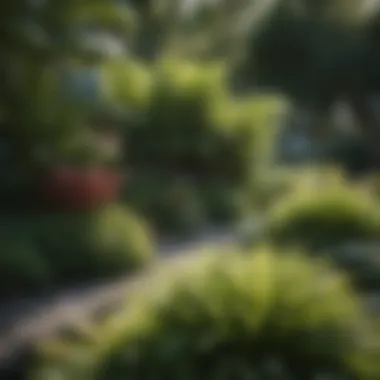

A common technique for watering smaller areas is applying water in the early morning or late evening. At these times, the temperature is cooler, which reduces evaporation and allows your plants to absorb more moisture. Remember to adjust the watering frequency based on rainfall.
Soil Quality and Fertilization
Soil plays a fundamental role in plant health. In a small garden, the soil quality can determine the overall success of your plants. Conducting a soil test can help assess pH levels and nutrient density. If the soil lacks essential nutrients, adding organic matter, like compost, can improve its quality. Composting not only provides nutrients but also enhances soil structure, allowing for better moisture retention.
Regular fertilization is also key to maintaining plant health in small spaces. Use slow-release fertilizers as they provide a steady supply of nutrients over time. This method reduces the risk of nutrient runoff and ensures consistent feeding. Look for organic options that are kinder to the environment and beneficial for microbial life in the soil.
Pest Management in Compact Spaces
Managing pests in a small garden can be challenging due to close proximity of plants. Effective strategies must be put in place to protect your crops. Integrated Pest Management (IPM) can be beneficial here. This method combines biological control, habitat manipulation, and the use of resistant plant varieties.
Regular inspections of your plants can help detect pests early. If you notice any infestations, consider using neem oil or insecticidal soap, which are less harmful to beneficial insects. Companion planting can also deter pests naturally; for instance, planting marigolds may help keep aphids at bay.
Proper maintenance and care ensure that small gardens can be productive and beautiful. Good practices promote plant health, making the most of your limited space.
Sustainability Practices
Sustainability practices in small gardens are essential for promoting a healthier environment and maximizing resources. As urban spaces become more crowded, the importance of incorporating sustainable techniques is increasingly recognized. These practices not only help reduce waste and conserve water, but they also contribute to the overall fertility of the garden ecosystem. With limited space, gardeners must carefully consider their approaches to sustainability to achieve the best results.
Composting for Small Gardens
Composting is a transformative practice that can significantly benefit small gardens. By converting kitchen scraps and yard waste into nutrient-rich compost, gardeners can improve soil health without relying on chemical fertilizers. This is especially valuable in small gardens where soil quality can be poor. A compost bin or even a simple heap can be maintained in a corner of the garden.
Starting a compost pile may seem daunting, but it is quite simple:
- Select a location that is easily accessible yet out of sight.
- Choose the right materials: Include food scraps like fruit and vegetable peels, coffee grounds, and eggshells, along with yard waste such as leaves and grass clippings.
- Maintain a balance of green materials (nitrogen-rich) and brown materials (carbon-rich) to promote decomposition.
Over time, this compost can be used to enhance the soil, help retain moisture, and improve drainage, ultimately supporting robust plant growth. This practice not only reduces waste but also creates a cycle of nourishment for the garden.
Rainwater Harvesting Techniques
Rainwater harvesting is an effective way to conserve water in small gardens. Collecting rainwater reduces reliance on municipal water systems and can lower water bills. It also helps mitigate stormwater runoff, which is beneficial for the surrounding environment.
Setting up a rainwater harvesting system is straightforward:
- Install a rain barrel beneath your gutter downspout. Make sure it has a lid to prevent debris and mosquito breeding.
- Connect a filter or diverter to keep the water clean as it enters the barrel.
- Utilize the collected rainwater to irrigate your garden during dry periods. This is particularly useful for growing vegetables and fruits that require regular watering.
Utilizing rainwater for gardening purposes can be both environmentally friendly and cost-effective.
Natural Pest Control Methods
Managing pests naturally is a crucial aspect of sustainability in small gardening. Chemical pesticides can harm beneficial insects and disrupt the balance of the garden ecosystem. By adopting natural pest control methods, gardeners can effectively minimize pest issues while promoting biodiversity.
Some effective natural strategies include:
- Encouraging beneficial insects: Planting flowers like marigolds can attract ladybugs and lacewings that prey on pests.
- Neem oil: Derived from the seeds of the neem tree, this oil acts as a natural pesticide that disrupts the life cycle of various insects.
- Companion planting: Certain plants can repel pests when grown together. For example, planting basil near tomatoes can deter whiteflies.
By focusing on natural pest control, gardeners can maintain a healthy garden environment, reduce chemical dependency, and promote long-term ecological sustainability.
Gardening is not just about what you grow; it’s about how you grow it, including the impact on the environment.
Epilogue and Future Prospects
In the realm of small gardens, the potential for creativity and productivity is vast. This article emphasizes the importance of carefully selecting plants that thrive within confined spaces. By understanding the unique characteristics of various herbs, vegetables, fruits, and ornamental plants, gardeners can make informed decisions tailored to their environment.
Adopting a sustainable approach not only benefits the plants but also enhances the overall quality of the garden. Practices such as composting and rainwater harvesting contribute to the health of the ecosystem while promoting a sense of responsibility towards the environment.
In the years to come, small gardens will likely continue to evolve. Urbanization and limited land availability push individuals towards innovative gardening techniques that maximize yield.
Reflecting on Gardening Experiences
As gardeners conclude each season, reflecting on their experiences proves essential. Engaging with nature in a small garden setting promotes mental well-being and instills a sense of accomplishment. Each plant tells a story of its journey from seed to harvest or bloom.
Challenges like pest management or unexpected weather can arise, yet they offer learning opportunities. Sharing these experiences within communities, such as on platforms like Reddit or Facebook, can foster a culture of support and knowledge exchange, enhancing the overall gardening experience for everyone involved.
The Evolution of Small Gardening Trends
The evolution of small gardening trends is notable. Historically, the concept of gardening was often tied to larger plots and extensive landscaping. However, recent years have seen a shift towards minimalism and functionality.
Modern gardening practices now embrace vertical spaces, container gardening, and hydroponic setups. There is an increased interest in cultivating organic produce, focusing on local resources, and optimizing every inch of available space.
As societal trends continue to emphasize sustainability, the future of small gardens will likely align with eco-friendly practices, offering new methods for thriving in limited areas. This continuous evolution ensures that small gardens remain relevant and beneficial to both individuals and the broader community.







